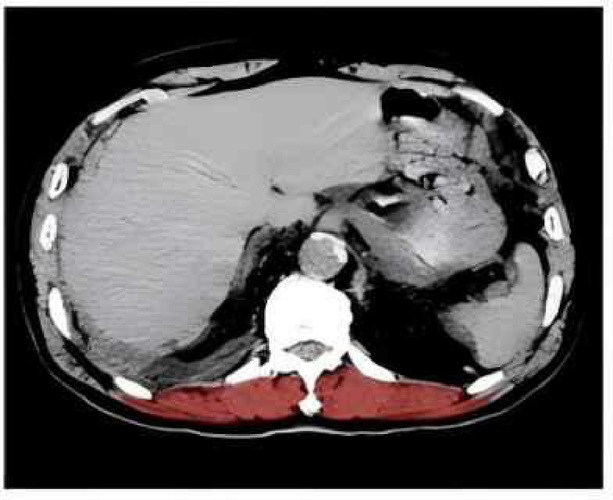Characteristics of patients with AECOPD
Figure 2 showed the flow chart of the study. There were 236 AECOPD patient included in the present study. According to the quartile of ESMCSA, patients were divided into 2 groups: less than the quartile (< 23.65cm2, lower group), and more than quartile (≥ 23.65cm2,normal group), The demographic characteristics of the 236 patients who were included in the data analysis are presented in Table 1. There were 59 and 177 patients in the lower group and normal groups respectively. There were more males, current smokers and less comorbidities with coronary heart disease (CHD), diabete in the ESMCSA normal group(p < 0.05). And there were more subjects with old age and frequent exacerbation in the ESMCSA lower group. There were nonsignificant associations of ESMCSA with PaO2, pH, BMI, PaCO2, lung function, comorbidity with hypertension, congestive heart failure, renal dysfunction, exacerbations during preceding year and respiratory failure (P > 0.05).
The flow chart of the study.
ESMCSA and 1-year rehospitalization for AECOPD
A total of 112 patients suffered from 273 hospitalizations for AECOPD within 1 year after discharge from the hospital. The survival plot of the time to first hospitalization for AECOPD according to the erector spinae muscle area on admission is presented in Fig. 3 (p = 0.001 by the log-rank test).

The survival plot of the time to first hospitalization for AECOPD according to the levels of the cross-sectional area of the erector spinae muscle.
Univariate cox regression analysis showed that ESMCSA, PaCO2, BMI, frequent exacerbation and respiratory failure were associated with the 1-year first hospitalization for AECOPD (Table 2).
Multivariate cox regression analysis showed that only ESMCSA and BMI were associated with the 1-year first hospitalization for AECOPD (Table 2).
For the rate of hospitalization for AECOPD, in univariate poisson regression analysis, ESMCSA were associated with the risk of hospitalization for AECOPD (IRR = 0.57, 95% CI 0.45–0.73, P = 0.000). In the multivariate analyses, ESMCSA remained an independent predictor of a higher risk of hospitalization for AECOPD (IRR 0.56, 95% CI 0.43–0.72) at the 1-year follow-up. The other factors associated with the rate of hospitalization for AECOPD were PaO2, PaCO2, frequent exacerbation in the previous years, respiratory failure, and lung function status (Table 3).
ESMCSA and 1-year mortality
Seventeen patients died within 1 year after discharged from the hospital, and the 1-year mortality were 15.3% and 4.5% for the ESMCSA lower group, and normal groups respectively. The survival plot of the time to 1-year death according to the levels of ESMCSA on admission is presented in Fig. 4 (p = 0.007 by the log-rank test).

The survival plot of the time to death for AECOPD according to the levels of the cross-sectional area of the erector spinae muscle.
In univariate cox regression analyses, age, PaO2, CHD, CHF were associated with 1-year mortality, whereas PaCO2, and BMI were not. However, multivariate cox regression analysis confirmed that age, PaO2, CHF were associated with 1-year mortality (Table 4).
Both univariate (HR = 0.29 95% CI: 0.11–0.75, P = 0.011) and multivariate cox regression analyses (HR = 0.35, 95% CI: 0.12–0.99, P = 0.048) showed that ESMCSA were associated with 1-year mortality (Table 4).
Sensitivity analysis
We performed sensitivity analysis to evaluate the effect of the ESMCSA adjust to gender, gender and height on 1-year mortality and rehospitalizations for AECOPD. The sensitivity analysis showed that when ESMCSA adjust to gender, lower ESMCSA were a independent risk factor for first rehospitalization and rehospitalization rate within 1 year (Table 5). When ESMCSA adjust to gender and height, lower ESMCSA-I were an independent risk factor for first rehospitalization and rehospitalization rate within 1 year (Table 5). At the same time, univariate cox regression analyses showed that the lower ESMCSA adjust to gender were risk factor for 1-year mortality. However, multivariate cox regression analyses showed ESMCSA adjust to gender were not risk factor for 1-year mortality (Table 5). Univariate cox regression analyses showed that the lower ESMCSA-I were risk factor for 1-year mortality. However, multivariate cox regression analyses not confirmed it (Table 5).
